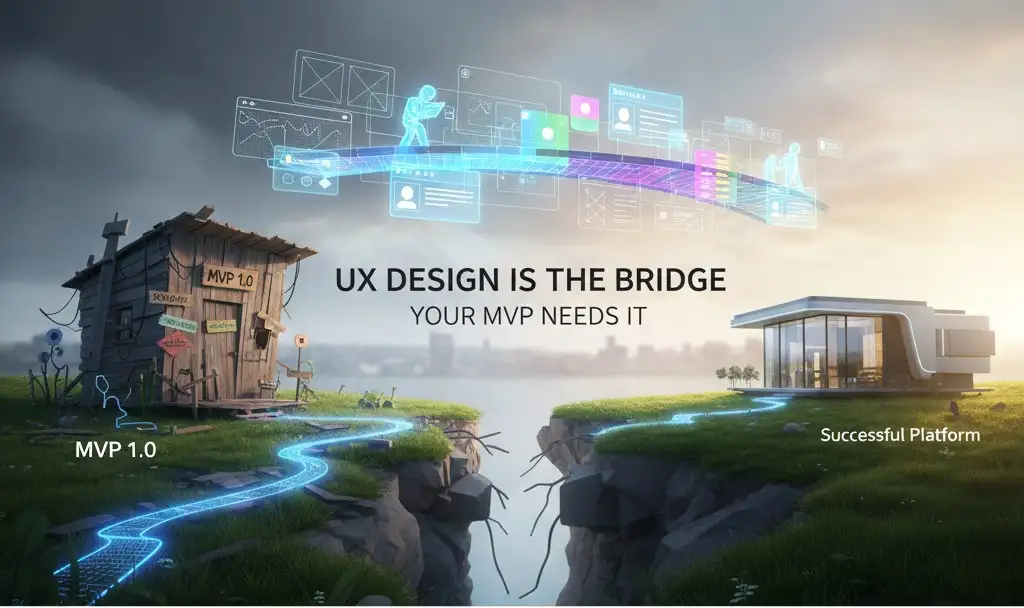Why UX Matters: How Great User Experience Transforms Small Products
Published by: Gautham Krishna ROct 22, 2025Blog
Companies that prioritize user experience design see conversion rates up to 400% higher than those that don't, proving that exceptional UX isn't just for tech giants with massive budgets. At Evalogical, we've witnessed how startups and small businesses implementing professional UX design services achieve 2x faster user adoption and 45% higher retention rates--regardless of their product's scale or complexity.
User experience design represents the fundamental relationship between your product and the people who use it. When executed effectively, it transforms functional tools into indispensable solutions that users not only tolerate but genuinely enjoy using.
The Tangible Business Impact of UX Design
Many product teams still view UX as a "nice-to-have" aesthetic enhancement rather than a core business driver. The data tells a different story:
- ROI-focused: For every $1 invested in UX, businesses earn $100 in return--an astonishing 9,900% ROI
- Retention-boosting: Well-designed user interfaces can increase customer retention by up to 30%
- Development-efficient: Fixing problems during design costs 10-100x less than post-development fixes
- Competitively decisive: 70% of online businesses fail due to bad usability, not missing features
These statistics underscore why user experience design matters equally for modest products and enterprise solutions. In fact, smaller products often benefit more dramatically from UX improvements since they typically serve more focused use cases.
Why Small Products Benefit Most from UX Focus
Limited Resources Demand Maximum Impact
Startups and small businesses operate with constrained development resources. Unlike large corporations that can overcome mediocre UX with massive marketing budgets or established brand loyalty, smaller products must deliver immediate value and intuitive interaction from the first touch.
A minimal viable product with thoughtful UX often outperforms a feature-rich application with confusing navigation. This explains why MVP development with UX focus yields disproportionately positive results for early-stage companies.
The Compound Benefits of Early UX Investment
Integrating UX design from your product's inception creates compounding advantages:
- Stronger foundation: User-centered architecture scales more efficiently
- Reduced rework: Early usability testing prevents expensive redesigns
- Clearer direction: User research informs feature prioritization
- Faster adoption: Intuitive interfaces decrease learning curves
Small products that bake UX into their DNA from the beginning typically reach product-market fit 30-50% faster than those that treat design as an afterthought.
Practical UX Principles for Immediate Implementation
Start with User Journey Mapping
Before writing code or designing pixels, document the complete path users take to accomplish their goals. Identify:
- Entry points: Where do users first encounter your product?
- Critical tasks: What 2-3 actions are essential to delivering value?
- Potential friction: Where might confusion or abandonment occur?
- Success moments: What experiences will make users feel accomplished?
Embrace Progressive Disclosure
Avoid overwhelming users with options. Instead, reveal features and information gradually as users need them. This approach:
- Reduces cognitive load for new users
- Prevents feature paralysis
- Creates natural learning pathways
- Maintains clean, uncluttered interfaces
Design for Consistency
Maintain consistent patterns across your product for:
- Navigation placement and behavior
- Button styles and interaction feedback
- Terminology and labeling
- Error messages and recovery paths
Consistency reduces learning requirements and builds user confidence.
Prioritize Loading States and Feedback
Users need to understand what's happening at all times. Ensure your product provides:
- Immediate feedback for user actions
- Clear loading indicators for processes taking longer than 1 second
- Helpful error messages that suggest solutions
- Visual confirmation of completed actions
FAQs
Q: How can small teams with limited budgets improve UX?
A: Start with these cost-effective approaches:
- Conduct guerrilla usability testing with 5-8 potential users
- Use free prototyping tools like Figma for early validation
- Analyze heatmaps and session recordings from tools like Hotjar
- Implement consistent design patterns rather than custom solutions for every element
Q: What's the most overlooked aspect of UX in small products?
A: Error handling and recovery. Many teams design only for happy paths, but how your product behaves when things go wrong often determines user retention. Thoughtful error states and clear recovery instructions significantly impact perceived reliability.
Q: How do I measure UX success quantitatively?
A: Track these fundamental metrics:
- Task success rate: Can users complete key actions?
- Time-on-task: How long do important actions take?
- Error rate: How often do users make mistakes?
- User retention: Do people return after their first visit?
Q: When should I invest in professional UX help?
A: Consider professional UI/UX design services when:
- You're preparing for a major user acquisition push
- Development is consistently blocked by design questions
- User feedback repeatedly mentions confusion or difficulty
- You're planning to scale your product significantly
Transforming Products Through User Experience
The question isn't whether your small product can afford to invest in UX--it's whether you can afford not to. In today's competitive landscape, user experience has become the primary differentiator for digital products of all sizes.
Companies that recognize why UX matters and implement thoughtful design systems position themselves for disproportionate growth. They convert casual users into passionate advocates, reduce support costs through intuitive interfaces, and build products that people genuinely enjoy using.
As you evaluate your product's current experience, remember that UX excellence isn't about revolutionary innovations,it's about consistently removing friction and delivering value at every touchpoint. Small, deliberate improvements compound into transformative experiences that drive business results.
Ready to transform your product through exceptional UX?



 UX Design for Startups: Why Yo....
UX Design for Startups: Why Yo....
 ColdFusion End-of-Life: The Cr....
ColdFusion End-of-Life: The Cr....
 A Proven ColdFusion Migration ....
A Proven ColdFusion Migration ....
 ColdFusion Maintenance Guide: ....
ColdFusion Maintenance Guide: ....
 Brand Refresh vs. Rebrand: You....
Brand Refresh vs. Rebrand: You....



Your Trusted Software Development Company